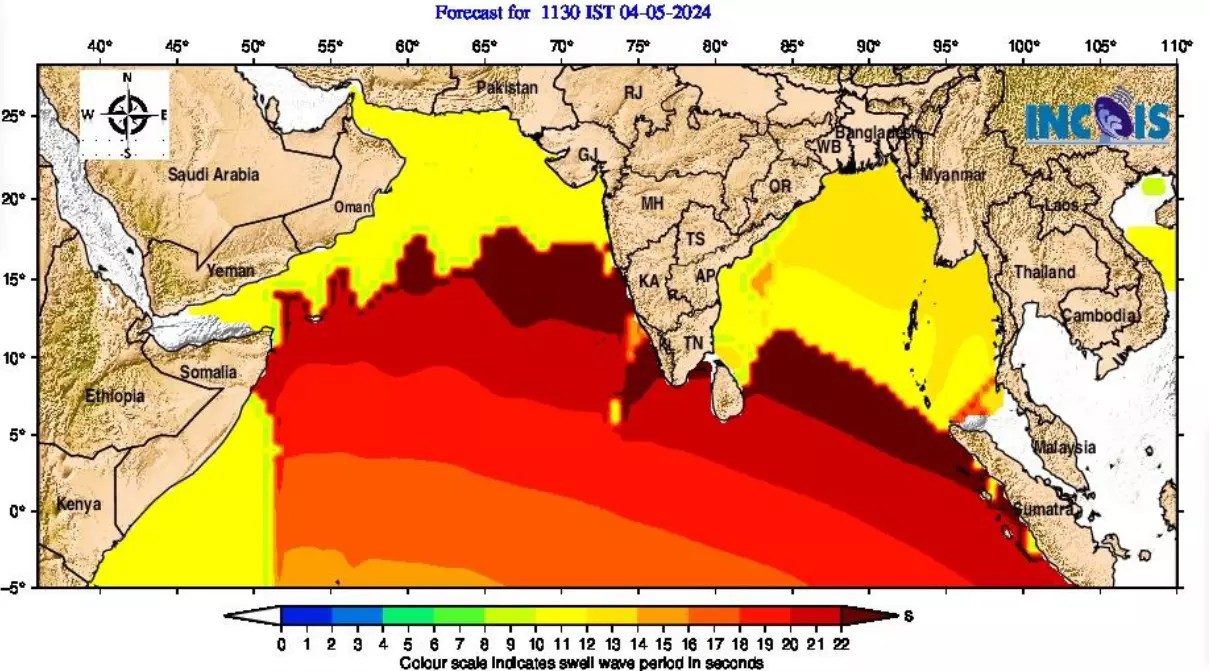Coastal States Put on Alert for Surge Swell in Sea

Hyderabad: Scientists have advised a total suspension of all recreational activities along the coast and beaches of many states on India’s western and eastern coasts on Saturday and Sunday, warning of a potentially dangerous swell in waves hitting the coastal regions.
The alert was put out by the Hyderabad-based Indian National Centre for Ocean Information Services (Incois) and covers Lakshadweep, Kerala, south Tamil Nadu, Karnataka, Goa, Maharashtra, Andaman and Nicobar Islands, Odisha and West Bengal
Incois said the swell surge could last up to 30 seconds or more and this could mean higher waves, especially if the surge time coincided with high-tide periods.
According to Nagaraja Kumar, scientist and head of the operational ocean cervices division of Incois, the surge swell began some 10,000 kilometres away somewhere in the Atlantic Ocean on April 26 and its first impact is likely to be felt on the southern tip of India sometime late on Thursday night or early hours of Friday.
“There is no threat to shipping or fisheries but the impact will be felt on the coast,” he said.
The swell surge has been travelling at a great speed, and has moved through the Indian Ocean at around 60 kmph, or 1,420 km per day. According to V. Chandrashekar, scientist at Incois, this event had its origins in high-speed winds in the Atlantic pushing the sea water northwards.
The swell is expected to cross Lakshadweep in Western Indian Ocean and the Andaman and Nicobar islands in south Bay of Bengal late on Thursday night.
A warning is in place for these two island groups and southern Tamil Nadu and Kerala while much of the rest of the Indian coastline that is is expected to feel the impact of the surge swell put on an ‘alert’ status. “By Friday, we will have more readings and will be able to predict how the swell will behave,” Chandrashekar said.
Tamil Nadu and Kerala could see wave height along their coasts rise by 0.5 to 1.5 metres during the event.
“This is a high energy event. Though there were two other surge swells earlier, the present one is bigger. It is not as much as the height of the swell in the sea and the waves but the duration that matters. Typically, Incois issues alerts if a swell is expected to last 18 seconds. The one coming now is expected to last for 30 seconds or more. So, people along the coast in the regions expected to be affected should be on the alert for unexpected gushing of sea water inland,” Nagaraja Kumar said.
Interestingly, though Odisha and West Bengal have also been placed on alert, no alert was issued for Andhra Pradesh by Friday evening. Sri Lanka which will also experience the surge, is acting as a shield and the surge swell will get divided into two with one of its arms moving towards Odisha and Bengal. “AP may experience the surge but the phenomenon there is likely to be delayed,” Chandrashekar explained.
If the surge swell continues its way north without dissipating, then its impacts could also be felt on the eastern seaboard of Somalia in Africa, and Yemen, and Oman in the southern Arabian peninsula.
Incois in a news release, said “fishermen and coastal population are alerted to be cautious on possible surging of waves (gushing of sea water) intermittently in the nearshore/beach region, particularly in the low-lying areas. Small vessels should not ply nearshore. Boats may be anchored at a fair distance from each other, to avoid collision and damage.” It further called for a “total suspension of operational and recreational activities at beaches and nearshore regions on May 4 and 5.”

